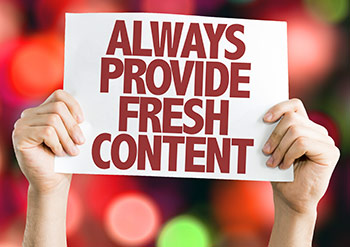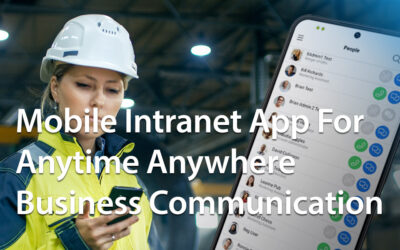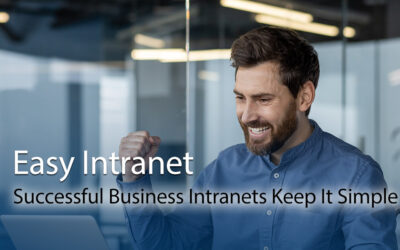So your company’s office intranet is finally up and running – let’s call that step one! Now it’s time to move onto step two; creating intranet content that your employees will want to engage with. Unfortunately, too many businesses think that once the office intranet has been deployed that the job, besides technological maintenance and support, is done. Many would think that the overall success of your company’s intranet comes down to the latest technological features. However, we firmly believe that success comes down to whether or not your office intranet content is relevant and engaging for your employees.
There’s no point having a nifty intranet with all the latest features if your employees aren’t eager to use it daily. That’s why we’ve created our top five tips to help your company produce an intranet that is engaging and relevant to all employees:
1. A Picture Is Worth A Thousand Words
 Ideally, companies would want employees to take the time to read documents and become insightfully informed on various topics, such as health and safety procedures, that the company takes the time to publish. However, in reality, it is very rare that employees will take the time to read every word of text. In fact, research suggests that when people read from computer screens, only 28% of the text is actually read. Rather, people skim read to understand the main points of information.
Ideally, companies would want employees to take the time to read documents and become insightfully informed on various topics, such as health and safety procedures, that the company takes the time to publish. However, in reality, it is very rare that employees will take the time to read every word of text. In fact, research suggests that when people read from computer screens, only 28% of the text is actually read. Rather, people skim read to understand the main points of information.
“A picture is worth a thousand words.” That old English idiom that we’ve heard time and time again is highly relevant in terms of your company’s intranet. In other words, a complex idea can be summarized and conveyed through an image. For example, convoluted information regarding a particular mundane health and safety procedure can easily be communicated in a flow chart or diagram. Relaying the same information in writing may take up to 3 pages and who has the attention span or time to read that? Instead, employees can familiarize themselves with the diagram and refer to any additional written information to gain further knowledge.
Large documents of text can be overwhelming for the reader. Breaking up large chunks of writing with graphics, photographs or other images will make the content more appealing and eye-catching while reinforcing the information that is being presented. To create truly meaningful and credible content to your company’s intranet, add images from your workplace instead of just stock images from Google.
The visual appeal of your company’s intranet is vital to creating the pop and pow needed to both attract and keep the attention of employees.
2. Who Is The Reader?

Employees are much more likely to engage with an intranet that mimics a conversational tone, rather than the formal language you may use when conversing with the public or other partnering businesses. Avoid acronyms or jargon unless they’re common knowledge throughout the whole company, such as the name of a department. Otherwise, you might just find them creating confusion among your employees!
Let’s look at an example to see how this works in an office setting. Susie in the sales department is likely to have a high interest in the new product information manual, as she’ll want detailed knowledge of the product range and the applications. Therefore, this document can include jargon and lingo that Susie and other employees in the sales department will understand. Whereas Denise, who is in the distribution department, is unlikely to understand the jargon and doesn’t need to have the same in-depth knowledge as Susie. Therefore a summary of the product information, along with comprehensive information regarding the distribution process of the range, will be more suited for Denise.
3. Grab Employee’s Attention

As we shared already, as little as 28% of text is read, and many employees are adopting a scan read technique. Eye-tracking studies support this conclusion as it has shown that most online readers prefer to scan webpages, rather than reading each word. This is where typography tricks come in handy. By adding bullet points and subheadings to break up large blocks of text, you are not only adding visual differentiation but also summarizing and highlighting the main points.
The use of different fonts and typography is a simple yet effective trick to grab your reader’s attention.
4. Engage Employees With Interactive Content
Instead of having employees passively reading over the intranet, try creating an interactive platform to further increase an employee’s engagement. Intranet features such as discussion forums and collaborative workspaces give employees the opportunity to communicate through the intranet to other employees across departments.

5. Fresh And New Content
Is the information on your intranet out of date? If it is, it’s probably time to delete and refresh it immediately. There is nothing more disengaging than an employee logging onto the intranet to find the same information on the landing page as was there yesterday. A landing page should look different each day, especially as it generally immediately informs employees on company updates and news. Likewise, when an employee is accessing documents, they need this information to be up to date. There’s nothing worse than having your employee unaware of changes regarding a particular procedure and then potentially passing this incorrect information over to the client or customer.

Wait, There’s A Third Step?
Step two, creating meaningful and relevant content, is a never-ending process. That being said, step three is also vitally important and can’t be neglected. Reviewing the engagement levels of your company’s intranet and getting feedback from employees regularly is essential to a successful intranet. The evaluation of current content helps ensure that you stay on point and continue to create content for the office that is both relevant and engaging. If you need advice around company intranets and how to enhance staff engagement with quality content, contact the team at MyHub today.







